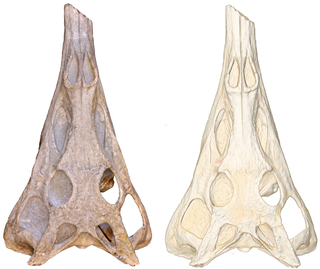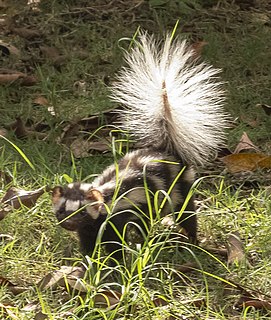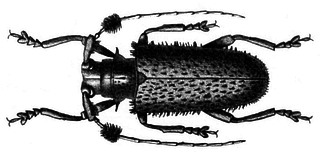
Paleorhinus is an extinct genus of basal phytosaur known from the Late Triassic of Texas and Wyoming, United States, Bavaria, Germany and possibly Poland. It contains two valid species, the type species: Paleorhinus bransoni and Paleorhinus angustifrons. Paleorhinus had a length of about 2.5 meters.

The russet-backed oropendola is a species of bird in the family Icteridae. It is found in wooded habitats in the highlands of the northern and central Andes and the Venezuelan Coastal Range, and in lowlands of the western Amazon. It is generally common and widespread. Males are larger than females, but otherwise the genders are similar. Its plumage is mainly olive and brown, and the outer rectrices are contrastingly yellow. The lowland nominate subspecies has a black bill, while the highland subspecies all have pale bills. These have been regarded as separate species, but as they hybridize freely, all major authorities now regard them as a single species.

Lates angustifrons, the Tanganyika lates, is a species of lates perch endemic to Lake Tanganyika. It is a widespread predator on other fishes. This species can reach a length of 200 centimetres (79 in) SL and the greatest recorded weight is 100 kilograms (220 lb). This species is important commercially and is also popular as a game fish. It is threatened by the pressures that these activities put upon the population.
Ebrachosuchus is an extinct genus of basal phytosaur known from the Late Triassic of Bavaria, southern Germany. It is known only from the holotype BSPG 1931 X 501, a complete skull missing both mandibles. It was collected at Ebrach Quarry, bed number 9 from the late Carnian-aged Blasensandstein Member of the Hassberge Formation. It was first named by Oskar Kuhn in 1936 and the type species is Ebrachosuchus neukami.

The southern spotted skunk is a species of mammal in the skunk family, (Mephitidae). It ranges from Costa Rica to southern Mexico. At one time this skunk was considered to be a subspecies of the eastern spotted skunk.
Scalenodon is an extinct genus of traversodontid cynodonts from the Middle Triassic of Africa and possibly Russia. The type species S. angustifrons was named in 1946 and several other species were named in the following years. Most of the species from Africa are now thought to belong to different genera than Scalenodon.
Mandagomphodon is an extinct genus of traversodontid cynodonts from the Middle Triassic Lifua Member of the Manda Beds of Ruhuhu Valley, Tanzania. The type species Mandagomphodon hirschsoni was named by Crompton in 1972 as a species referable to Scalenodon. Later studies, including a 2003 phylogenetic analysis of traversodontid relationships, did not find the species of Scalenodon from the Manda Formation to form a single clade, meaning that many were not referable to the genus. The study suggested that S. hirschsoni had more in common with other traversodontids like Luangwa. S. attridgei was viewed as a possible synonym of S. charigi, which was also found to be only distantly related to S. angustifrons. Therefore, a new generic name Mandagomphodon was erected for S. hirschsoni by James A. Hopson in 2013.

Aristobia approximator is a species of beetle in the Longhorn family. This species grows to 36mm.

Aristobia freneyi is a species of beetle in the family Cerambycidae. It was described by Schmitt in 1992. It is known from Thailand.

Aristobia hispida is a species of beetle in the family Cerambycidae. It was described by Saunders in 1853, originally under the genus Cerosterna. It is known from Taiwan, China and Vietnam.

Aristobia horridula is a species of beetle in the family Cerambycidae. It was described by Frederick William Hope in 1831, originally under the genus Lamia. It is known from Myanmar, Laos, Taiwan, China, Thailand, and Vietnam.
Aristobia laosensis is a species of beetle in the family Cerambycidae. It was described by Eric Jiroux, Philippe Garreau, Joan Bentanachs and Patrick Prévost in 2014. It is known from Laos.
Aristobia quadrifasciata is a species of beetle in the family Cerambycidae. It was described by Per Olof Christopher Aurivillius in 1916 and is known from Sumatra and Malaysia.
Aristobia tavakiliani is a species of beetle in the family Cerambycidae. It was described by Eric Jiroux, Philippe Garreau, Joan Bentanachs and Patrick Prévost in 2014. It is known from Malaysia.

Aristobia umbrosa is a species of beetle in the family Cerambycidae. It was described by James Thomson in 1865, originally under the genus Celosterna. It is known from Malaysia, Borneo and Sumatra. It contains the varietas Aristobia umbrosa var. variefasciata.

Aristobia voeti is a species of beetle in the family Cerambycidae. It was described by James Thomson in 1878. Although the name was originally spelled as "voetii", this spelling was not in use between 1894 and 2014, and therefore the spelling "voeti" must be preserved under ICZN Article 33.3.1, as this is the spelling that is in prevailing usage. It is known from Laos, China and Myanmar.

Aristobia reticulator is a species of beetle in the family Cerambycidae. It is known from Bhutan, Myanmar, India, China, Laos, Bangladesh, Thailand, and Vietnam. It feeds on Prunus persica, Liquidambar formosana, Quercus acutissima, Prunus salicina, and Nephelium mutabile. Many references list the name as Aristobia testudo, but this name, though published earlier, is unavailable under the ICZN, primarily in that Johann Eusebius Voet's 1778 work giving the name testudo fails to fulfill the requirement in ICZN Article 11.4 that a work must be consistently binominal; none of Voet's 1778 names, including testudo, are available.
Paragus angustifrons is a species of syrphid fly in the family Syrphidae.

Stenocatantops angustifrons, the Common Tropical Sharptail, is a species of short-horned grasshopper in the family Acrididae. It is found in Southeast Asia and Oceania.

Bovichtus angustifrons, the dragonet, horny, horny thornfish, marblefish, thornfish or variegated marblefish, is a species of marine ray-finned fish, a temperate icefish or thornfish, belonging to the family Bovichtidae. It is endemic to southeastern Australia and Tasmania on rocky reefs in shallow waters.













